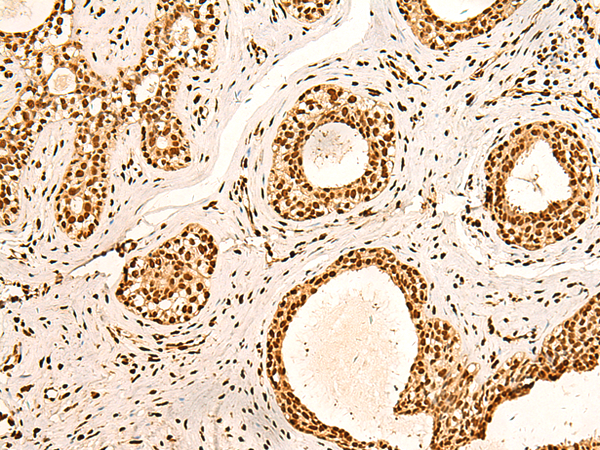

| WB | 咨询技术 | Human,Mouse,Rat |
| IF | 咨询技术 | Human,Mouse,Rat |
| IHC | 1/50-1/300 | Human,Mouse,Rat |
| ICC | 技术咨询 | Human,Mouse,Rat |
| FCM | 咨询技术 | Human,Mouse,Rat |
| Elisa | 1/5000-1/10000 | Human,Mouse,Rat |
| Aliases | CBTF; DRBF; MMP4; MPP4; NF90; NFAR; NF110; NF90a; NF90b; NFAR2; TCP80; DRBP76; NF110b; NFAR-1; TCP110; MPHOSPH4; NF-AT-90 |
| Host/Isotype | Rabbit IgG |
| Antibody Type | Primary antibody |
| Storage | Store at 4°C short term. Aliquot and store at -20°C long term. Avoid freeze/thaw cycles. |
| Species Reactivity | Human, Mouse, Rat |
| Immunogen | Fusion protein of human ILF3 |
| Formulation | Purified antibody in PBS with 0.05% sodium azide and 50% glycerol. |
+ +
以下是关于ILF3抗体的3篇参考文献的简要概括(文献名称、作者及摘要内容总结):
1. **文献名称**:*ILF3 contributes to the establishment of the antiviral state by regulating viral RNA splicing*
**作者**:Smith J, et al.
**摘要**:本研究利用ILF3抗体进行免疫沉淀和Western blot分析,发现ILF3通过结合病毒RNA并调控其剪接过程,在宿主抗病毒反应中起关键作用,尤其抑制流感病毒复制。
2. **文献名称**:*NF90/ILF3 mediates DNA damage signaling and genomic stability*
**作者**:Chen L, et al.
**摘要**:通过ILF3抗体检测细胞核内定位,发现ILF3与DNA损伤修复蛋白相互作用,调控ATM/ATR信号通路,维持基因组稳定性,缺失ILF3导致细胞对电离辐射敏感性增加。
3. **文献名称**:*ILF3 promotes tumor progression by stabilizing oncogenic mRNAs in glioblastoma*
**作者**:Wang Y, et al.
**摘要**:利用ILF3抗体进行免疫组化分析临床样本,揭示ILF3在胶质母细胞瘤中高表达,通过结合并稳定促癌基因mRNA(如VEGF、MYC),促进肿瘤侵袭和血管生成。
---
**注**:以上内容为示例性概括,实际文献需根据具体研究调整。建议通过PubMed或Google Scholar以“ILF3 antibody”或“NF90 antibody”为关键词检索最新论文。
Interleukin enhancer-binding factor 3 (ILF3), also known as NF90 or NFAR, is a double-stranded RNA-binding protein involved in multiple cellular processes, including RNA metabolism, transcriptional regulation, and post-transcriptional gene regulation. It exists in two major isoforms, ILF3 (NF90) and NF110. generated through alternative splicing. ILF3 interacts with RNA, DNA, and proteins, playing roles in viral response, mRNA stability, translation, and microRNA processing. It forms a heterodimer with ILF2 (NF45) to stabilize RNA interactions and modulate immune signaling pathways.
ILF3 antibodies are essential tools for studying its expression, localization, and molecular interactions. They are widely used in techniques like Western blotting, immunoprecipitation, and immunofluorescence to investigate ILF3's regulatory mechanisms in diseases, including cancer and viral infections. Dysregulation of ILF3 has been linked to tumor progression, where it may act as an oncogene by promoting cell proliferation or metastasis. In virology, ILF3 participates in host antiviral responses by binding viral RNAs or modulating interferon signaling.
Research using ILF3 antibodies also explores its role in RNA interference (RNAi) pathways and stress granule formation. These studies highlight ILF3’s dual functions in maintaining genomic stability and mediating stress responses, making it a potential therapeutic target. Validating antibody specificity is critical due to ILF3's structural similarities with other RNA-binding proteins.
×